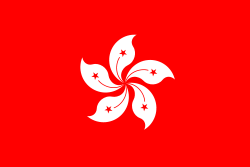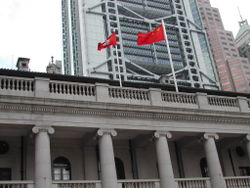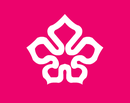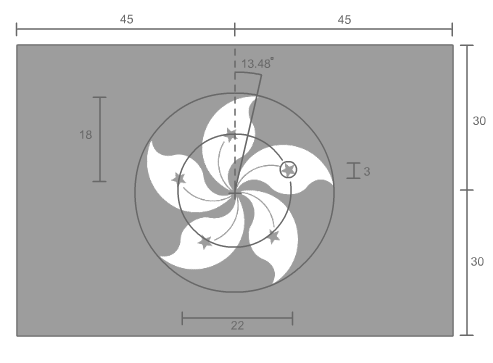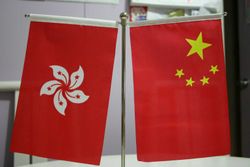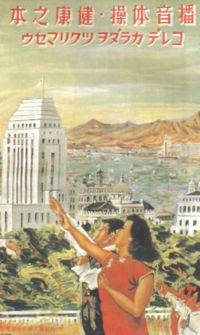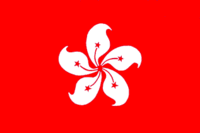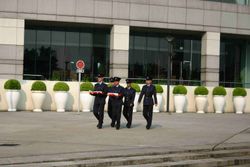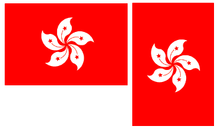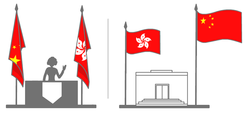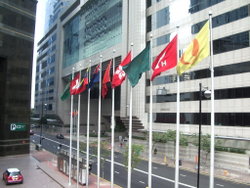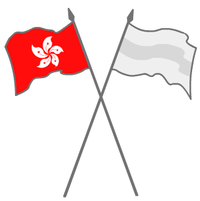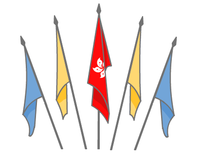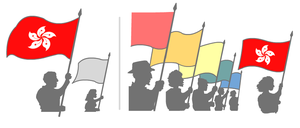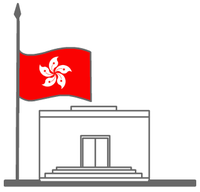Flag of Hong Kong
2007 Schools Wikipedia Selection. Related subjects: General Geography
The Regional flag of the Hong Kong Special Administrative Region of the People's Republic of China ( Traditional Chinese: 中華人民共和國香港特別行政區區旗; Simplified Chinese: 中华人民共和国香港特别行政区区旗) features a stylised, white, five-petal Bauhinia blakeana in the centre of a red field. The red colour on this flag coincides with the flag of the People's Republic of China.
The flag of Hong Kong was adopted on 16 February 1990, and received formal approval from the Preparatory Committee on 10 August 1996. The flag was first officially hoisted on 1 July 1997, in a historical ceremony marking the transfer of sovereignty from the United Kingdom to the PRC. The precise use of the flag is regulated through laws passed by the 58th executive meeting of the State Council held in Beijing.
The former colonial flag was used from 27 July 1959, to 30 June 1997, when Hong Kong was under British rule. It was a blue Union Jack ensign with the Hong Kong coat of arms on a white disk centred on the outer half of the flag. The 1876 design featured a colonial badge, showing a "local scene" instead of the Hong Kong coat of arms.
Design
Symbolism
The design of the flag carries cultural, political and regional meanings. The colour itself is significant: red is always the festive colour for the Chinese people, and one might remember that the People's Liberation Army was once called the Chinese Red Army. Thus, the colour conveys a sense of celebration and nationalism. Moreover, the red is identical to that used in the PRC flag, which implies the close linkage re-established between post-colonial Hong Kong and its mother country. The juxtaposition of red and white on the flag symbolises the one country two systems political principle applied to the region, with the stylised Bauhinia blakeana harmonising this dichotomy.
The bauhinia had been used as the official symbol of the now-defunct Urban Council since 1965 (depicted to the right). One may observe the design elements that have been incorporated into the Hong Kong flag.
Construction
When the flag is manufactured, the front and the back of the flag look identical to each other ( mirror image). The Hong Kong government has specified specific sizes, colours, and manufacturing parameters for the flag to be made in.
The background of the rectangular flag is red. It is also intended to be the same colour as that used for the PRC. The ratio of its length to breadth is 1.5. In its centre is a five petal stylised white bauhinia. The circle which circumscribes the bauhinia has a diameter 0.6 times the entire height of the flag. The petals are uniformly spread around the centre point of the flag, and radiate outwards in a clockwise direction. Each petal bears a red 5-pointed red star with a red trace, suggestive of a flower stamen. The red trace makes each petal look as if it is being divided in half. The heading that is used to allow a flag to be slid or raised onto a pole is white.
Size specifications
This table lists all the official sizes for the flag. Sizes deviating from this list are considered non-standard.
| Size | Length and width in cm |
|---|---|
| 1 | 288 × 192 |
| 2 | 240 × 160 |
| 3 | 192 × 128 |
| 4 | 144 × 96 |
| 5 | 96 × 64 |
| Car flag | 30 × 20 |
| Flag for signing ceremonies | 21 × 14 |
| Desktop flag | 15 × 10 |
Colour specifications
The following are the approximate colours of the Hong Kong flag in different colour models. It is sorted into the HTML RGB web colours ( hexadecimal notation); the CMYK equivalent; dye colours; HSL equivalent and the Pantone equivalent number.
| Colour | HTML | CMYK | Textile colour | HSL | Pantone |
|---|---|---|---|---|---|
| Red | #FF0000 | 0-87-99-0 | Chinese red | 0°,100%,50% | 186 |
| White | #FFFFFF | 0-0-0-0 | White | 0°,100%,100% |
Manufacturing process
If a flag is not being produced according to Hong Kong Basic Law, the Secretary of Justice has the ability to petition to the District Court for an injunction to prohibit the person and or company from manufacturing the flag. The District Court can also ask for the forfeiture of the flag and other materials used in the process of producing the flags. If the District Court agrees that the flags are found to be not in compliance, the District Court can issue the injunction and order that the flag and the materials that were used to make the flag to be seized by the Government.
History
Historical flags
The flag of colonial Hong Kong underwent several changes in the last one and a half centuries. However, the history behind the changes is incomplete as some information regarding the authorities who commissioned the changes were not documented properly during that period.
In 1843, the Seal of Colony was instituted. The design was based on a local waterfront scene (see the 1876 flag below): three local merchants with their commercial goods can be found on the foreground, a square-rigged ship and a junk occupy the middle ground, while the background consists of some conical hills and cloud. In 1868 a Hong Kong flag was produced, with a badge based on the "local scene", but was rejected by Governor Richard Graves Macdonell.
In 1870, a "White crown over HK" layout was proposed by the Colonial Secretary. The letters "HK" were omitted and the crown became full-colour three years later. It is unclear what the badge was like during that period of time, but it was unlikely to be the "local scene". It should be a crown of some sort, which may, or may not, have had the letters "HK" below it. In 1879, the Seal badge was readopted with the Admiralty's approval.
On 17 November 1923, Governor Reginald Edward Stubbs replied to a question regarding white circles on colonial Blue Ensigns, the issue of concern being "the dark green of the Peak would be against the blue of the Ensign". The Colonial Office decided that the "dark green" writing at the border of the badge should consist of a series of tonal gradations from light blue, to light brown, and finally white. On 12 May 1924, Stubbs penned that the badge in the Flag Book had ...for some years past differed from the flag....Flag, that was even less attractive than that in the Flag Book, would be changed to correspond to it.
During the Japanese occupation of Hong Kong, the Japanese were harsh on the locals. They abolished many aspects of Chinese and British culture in Hong Kong, and forcefully instituted Japanese lifestyles in the region. The identity of Hong Kong was suppressed, and consequently all British and Chinese flags were abolished during this period; propaganda posters were distributed where the Japanese flag was canonised as Hong Kong's national flag.
In 1955 the idea of the Seal badge was revived. This occurred some years after World War II. The new badge was similar to the 1876 badge, but had a slightly lower eye-line, and a more realistic mountain on the left-hand side. The mountain, and the ship and junk, were made more prominent and embossed. A Coat of Arms for Hong Kong was granted on 21 January 1959 by College of Arms in London.
From 1959 onwards, Arms on white circular ground were implemented on Union Jack and Blue Ensign, likewise on unauthorised Red Ensigns.
Current design
Before the transfer of Hong Kong's sovereignty, a contest was held among Hong Kong people to help choose a flag for the newly created special administrative region. More than 7,000 designs were submitted for the contest; and a panel of political figures were nominated as judges. However, as the winning entries were rejected by the PRC, the famous architect Tao Ho was at last put in charge for the task.
Ho was originally chosen to be one of the panel judges to pick Hong Kong's new flag. The Shanghai-born artist recalled that some of the designs had been rather funny - some even had a political twist to them: "One had a hammer and sickle on one side and a dollar sign on the other." Six designs were chosen as finalists by the judges, but were all later rejected. Ho and two others were then asked by the PRC to submit new proposals.
Looking for inspiration, Ho wandered into a garden and picked up a bauhinia flower. He observed the symmetry of the five petals, and how their winding pattern conveyed a dynamic feeling. At last he incorporated this sense of energy into the flag to represent Hong Kong.
Proper flag protocol
The national and regional flags are flown daily from the Chief Executive's official residence, the Government House, the Hong Kong International Airport and at all border crossings and points of entry into Hong Kong. At major government offices and buildings, such as the Office of the Chief Executive, the Executive Council, the Court of Final Appeal, the Legislative Council, and the Hong Kong Economic and Trade Offices overseas, the national and the regional flags are displayed during days when these offices are working. Other government offices and buildings, such as hospitals, schools, departmental headquarters, sports grounds and cultural venues can fly the national and regional flags on certain occasions, such as the National Day (1 October), the Hong Kong Special Administrative Region Establishment Day (1 July), and the New Year's Day. The national and regional flags should be raised at sunrise (around 8:00 a.m.) and lowered around sunset (around 6:00 p.m.).
Respect for the flag
The Hong Kong Basic Law stipulates that the flag is the official symbol and ensign of the HKSAR. The Basic Law also stated that the residents of Hong Kong and various organisations respect and cherish the regional flag. The use and display of the regional flag is governed by the Regional Flag and Regional Emblem Ordinance. This ordinance spells out specifications of the flag as well as appropriate and inappropriate uses of the flag. Examples of inappropriate handling of the flag include displaying the flag upside down, letting the flag touch either the ground or water, dipped into any substance, or flown in times of bad weather. This is in contrast to flags of regimental colours, organisational or institutional flags which may be dipped to show honour to a person or object. Other inappropriate uses include using the flag:
- As a tablecloth
- As a drapery on a platform
- As covering for a statue, plaque, cornerstone, or similar object
- As part of a costume, clothing or a uniform
- In commercial advertising.
Furthermore, certain actions such as writing on the flag or using the flag to hold objects may be considered flag desecration. An exception is the use of flower petals when unfurling the flag.
Handling of the flag
There are a number of traditional rules of respect that should be observed when handling or displaying the flag. When the flag is used outdoors, the flag should always be hoisted at sunrise and lowered at sunset. However, weather conditions can make the use of a flag outdoors impossible. The flag may also be flown on a public building at night under special circumstances, such as the flag having lights pointed at it.
The flag should never be drawn, displayed or flown upside down. Tradition also states that when draped vertically, the flag should be rotated at a 90 degree angle and reversed. This is done because the top right (viewer's left) is the honour position of the flag. It is also considered disrespectful to display the flag that has been damaged, such as fraying of the edges (called the fly) or the colours of the flag are fading. Equipment that is used to fly flags, such as flag poles and halyards (ropes that are used to hoist the flag), should also be maintained on a regular basis.
Correct display
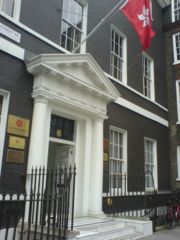
When two flags displayed on a wall horizontally behind a podium, their hoists should point towards each other with the saffron stripes at the uppermost. If the flag is displayed on a short flagpole, the flagpole is mounted at an 45 degree angle so the flag can be flown and there is nothing below touching the flag. If a national flag and a regional flag are displayed on crossed staffs, the hoists must be towards each other and the flags must be fully spread out. The flag should never be used as a table cloth to cover tables, cover podiums or be draped from railings.
With the National Flag
Whenever the National Flag (i.e. flag of the PRC) is flown together with the Regional Flag, the National Flag shall be flown in a prominent position. For example, the PRC flag would be flown above and placed to the centre of the HKSAR flag.
In addition, the following rules apply:
- The PRC flag is larger than the HKSAR flag
- The PRC flag is raised first when both flags are raised
- The PRC flag is always flown on the right of the HKSAR flag.
- The PRC flag is found to the right of the speaker while the HKSAR flag is on the left
- The PRC flag is placed to the viewer's right when outside, determined by a person standing in front of the building and looking towards the front entrance of the building.
However, for sporting event like Olympic medal ceremonies, since there is a chance that Hong Kong athletes win the gold medal while Mainland athletes win the silver or bronze, which with make the flag of China lower, or to the left of the Hong Kong flag, the rules do not apply.
With national flags of other countries
When the Regional Flag is displayed outdoors with other national flags, the Regional Flag must be flying at the far right (viewer's left) of the national flags on separate poles. Then, the national flags are arranged alphabetically according to their names in English. All the flags can be at the same sizes, but they cannot be larger than the Hong Kong flag.
The Regional Flag is allowed to be flown at the beginning and end of the row or included alphabetically in the middle of the row. In case when flags are flown in a closed circle, the Regional Flag should be flown from a significant point. The other flags should be raised in a clockwise manner until it comes back to the Regional Flag. The Regional Flag is the first to be raised and the last to be lowered.
When the flag is displayed on crossed poles, the pole using the Regional Flag should be in front and the flag is placed to the right (observers' left). However, if the flag of the United Nations is displayed, the Regional Flag can be flown from either side of the UN flag. Generally, the flag is displayed at the farther-most right (i.e. farther-most left of an observer facing the flags).
With non-national flags
When the flag is displayed with corporate flags or advertising banners, the Regional Flag should be placed either in the middle of the flags. When doing so, the flagpole containing the Regional Flag must be in front of the other flag poles. However, if the flags are flown from the same pole, the Regional Flag must be flown on top of the others. If the flags are being used in a parade, the Regional Flag must be at front and centre of the marching group or to the marching right if other flags are in the marching group.
Showing the flag indoors
Whenever the flag is displayed indoors at public meetings or gatherings, the flag should be placed to the right of the speaker or podium (observers' left), which is the position of honour. However, if the flag is not placed next to the speaker, the flag will be placed to the audience's far right.
When displaying the flag, the flag must include a saffron stripe on top. If hung vertically on the wall behind the podium, the saffron stripe should be to the left of the onlookers facing the flag with the hoist cord at the top.
Parades and ceremonies
When using the flag in a procession or parade, it should be either to the right of the other flags or alone at front and centre. The flag can be a displayed at the unveiling of a statue, monument, or plaque, but the flag is not supposed to be used to cover the objected that is being unveiled.
During either the flag hoisting or lowering ceremony or when the flag is passing in a parade or in a review, everyone who is present must stand at attention and face the flag. Those who are wearing a military uniform will also present their salutes at this time. The same rules apply when the flag is in a moving column. A dignitary can salute the flag either with or without a head cover. The national anthem should be played following the raising and saluting of the flags.
Half mast
The Regional Flag must be lowered to half staff (i.e. half mast) as a token of mourning when the following persons pass away:
- President of the People's Republic of China
- Chairman of the Standing Committee of the National People's Congress
- Premier of the State Council and Chairman of the Central Military Commission
- Chairman of the National Committee of the Chinese People's Political Consultative Conference
- Persons who have made outstanding contributions to the People's Republic of China as the Central People's Government advises the Chief Executive.
- Persons who have made outstanding contributions to world peace or the cause of human progress as the Central People's Government advises the Chief Executive.
- Persons whom the Chief Executive considers have made outstanding contributions to the Hong Kong Special Administrative Region or for whom he considers it appropriate to do so.
The Regional Flag may also be flown at half staff when the Central People's Government advises the Chief Executive to do so, or when the Chief Executive considers it appropriate to do so, on occurrences of unfortunate events causing especially serious casualties occur or serious natural calamities have caused heavy casualties.
Damaged flag
A Regional Flag that is either damaged, defaced, faded or substandard must not be displayed or used.
Disposal
When no longer in a fit condition to be used, a flag should be disposed of in a dignified manner, preferably by burning.
Desecration
It is a criminal offence in Hong Kong to desecrate the Regional Flag under the Regional Flag and Regional Emblem Ordinance (Cap 2602) s 7. For the protection of the regional flag and regional emblem, section 7 states: A person who desecrates the regional flag or regional emblem by publicly and wilfully burning, mutilating, scrawling on, defiling or trampling on it commits an offence and is liable:
- on conviction on indictment to a fine at level 5 and to imprisonment for 3 years; and
- on summary conviction to a fine at level 3 and to imprisonment for 1 year.
Leung Kwok-hung ("Long Hair"), a prominent political activist in Hong Kong, was penalised for writing on the HKSAR flag in 2001; an action which resulted in a fine of 3 000 HKD being levied on Leung. Leung claimed that, however, he just wanted to write down his wishes upon Hong Kong on the flag.
Trivia
During the opening ceremony of the 2004 Olympic Games in Athens, Greece, the Hong Kong team of athletes were hoisting a mirror image version of the flag, where the tips of the petals were pointing in the wrong direction. This was quickly corrected for the closing ceremony despite embarrassment caused.
